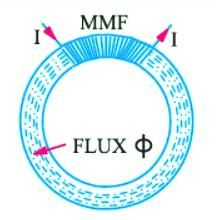Magnetic Circuit
It may be defined as the route or path which is followed by magnetic flux. The law of magnetic circuit are quite similar to (but not the same as) those of the electric circuit. Consider a solenoid or a toroidal iron ring having a magnetic path of l metre, area of cross section A m2 and a coil of N turns carrying I amperes wound anywhere on it as in Figure given below.
Then, as seen from Article Ampere’s Circuital Law, field strength inside the solenoid is


The numerator ‘Nl’ which produces magnetization in the magnetic circuit is known as magnetomotive force (m.m.f.). Obviously, its unit is ampere-turn (AT). It is analogous to e.m.f. in an electric circuit.
The denominator ![]() is called the reluctance of the circuit and is analogous to resistance in electric circuits.
is called the reluctance of the circuit and is analogous to resistance in electric circuits.
![]()
Sometimes, the above equation is called the “Ohm’s Law of Magnetic Circuit” because it resembles a similar expression in electric circuits i.e.
![]()
AdBlock-2
Definitions Concerning Magnetic Circuit
1. Magnetomotive force (m.m.f.): It drives or tends to drive flux through a magnetic circuit and corresponds to electromotive force (e.m.f.) in an electric circuit.
M.M.F. is equal to the work done in joules in carrying a unit magnetic pole once through the entire magnetic circuit. It is measured in ampere-turns.
In fact, as potential difference between any two points is measured by the work done in carrying a unit charge from one points to another, similarly, m.m.f. between two points is measured by the work done in joules in carrying a unit magnetic pole from one point to another.
2. Ampere-turns (AT): It is the unit of magnetomotive force (m.m.f.) and is given by the product of number of turns of a magnetic circuit and the current in amperes in those turns.
3. Reluctance: It is the name given to that property of a material which opposes the creation of magnetic flux in it. It, in fact, measures the opposition offered to the passage of magnetic flux through a material and is analogous to resistance in an electric circuit even in form. Its units is AT/Wb.
![]()
In other words, the reluctance of a magnetic circuit is the number of amp-turns required per weber of magnetic flux in the circuit. Since 1 AT/Wb = 1/henry, the unit of reluctance is “reciprocal henry.”
4. Permeance: It is reciprocal of reluctance and implies the case or readiness with which magnetic flux is developed. It is analogous to conductance in electric circuits. It is measured in terms of Wb/AT or henry.
5. Reluctivity: It is specific reluctance and corresponds to resistivity which is ‘specific resistance’.
Read article – magnetic circuit
Visit NCERTplanet.com for NCERT solutions and Textbook downloads




